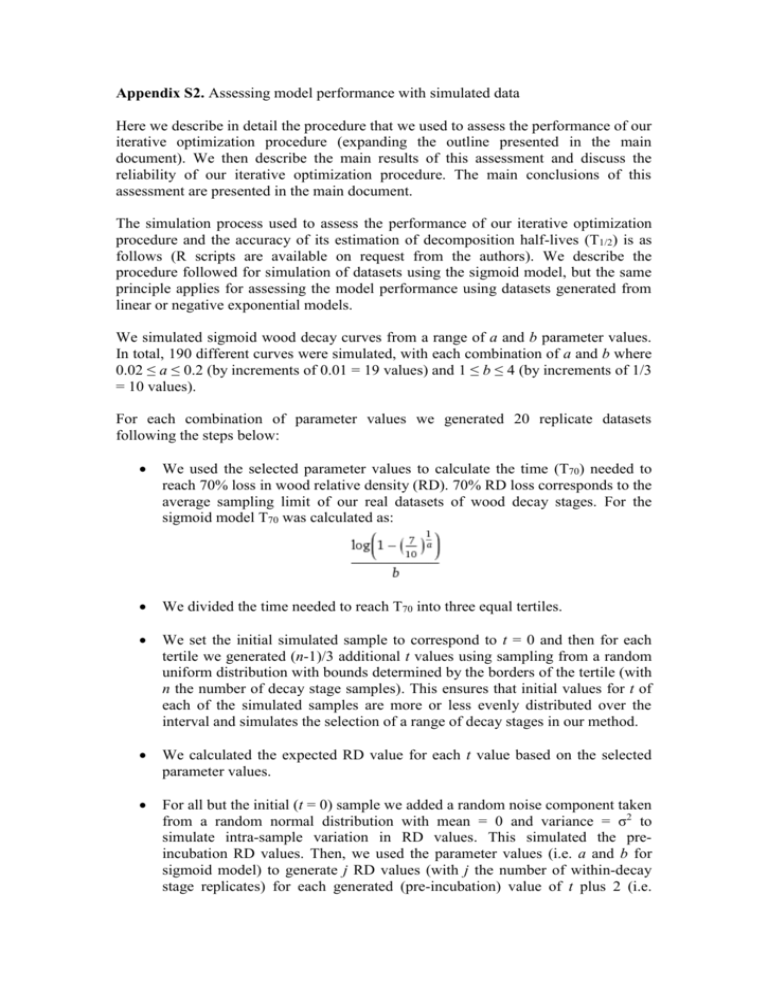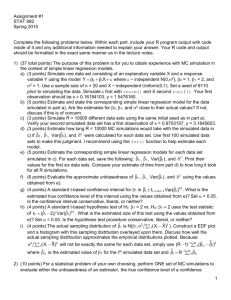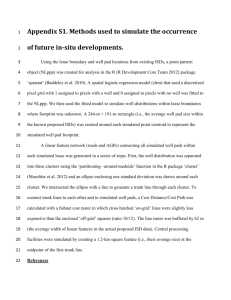JEC_1896_sm_AppendixS2
advertisement

Appendix S2. Assessing model performance with simulated data Here we describe in detail the procedure that we used to assess the performance of our iterative optimization procedure (expanding the outline presented in the main document). We then describe the main results of this assessment and discuss the reliability of our iterative optimization procedure. The main conclusions of this assessment are presented in the main document. The simulation process used to assess the performance of our iterative optimization procedure and the accuracy of its estimation of decomposition half-lives (T1/2) is as follows (R scripts are available on request from the authors). We describe the procedure followed for simulation of datasets using the sigmoid model, but the same principle applies for assessing the model performance using datasets generated from linear or negative exponential models. We simulated sigmoid wood decay curves from a range of a and b parameter values. In total, 190 different curves were simulated, with each combination of a and b where 0.02 ≤ a ≤ 0.2 (by increments of 0.01 = 19 values) and 1 ≤ b ≤ 4 (by increments of 1/3 = 10 values). For each combination of parameter values we generated 20 replicate datasets following the steps below: We used the selected parameter values to calculate the time (T70) needed to reach 70% loss in wood relative density (RD). 70% RD loss corresponds to the average sampling limit of our real datasets of wood decay stages. For the sigmoid model T70 was calculated as: We divided the time needed to reach T70 into three equal tertiles. We set the initial simulated sample to correspond to t = 0 and then for each tertile we generated (n-1)/3 additional t values using sampling from a random uniform distribution with bounds determined by the borders of the tertile (with n the number of decay stage samples). This ensures that initial values for t of each of the simulated samples are more or less evenly distributed over the interval and simulates the selection of a range of decay stages in our method. We calculated the expected RD value for each t value based on the selected parameter values. For all but the initial (t = 0) sample we added a random noise component taken from a random normal distribution with mean = 0 and variance = σ2 to simulate intra-sample variation in RD values. This simulated the preincubation RD values. Then, we used the parameter values (i.e. a and b for sigmoid model) to generate j RD values (with j the number of within-decay stage replicates) for each generated (pre-incubation) value of t plus 2 (i.e. length of incubation in years) and added noise component as above. This simulates the post-incubation RD values. Thus, for the sigmoid model, all 190 unique combinations of values of a and b were used to generate 20 unique datasets, for a total of 19 x 10 x 20 = 3800 simulations. All simulations used the average n, j and σ of our eight real wood decay stage datasets, i.e. n=10, j=4 and σ=0.025. An example simulated dataset for a sigmoid model with parameters a=0.1 and b=1.75, is shown in Fig. S1. Each plotting colour represents a different simulated wood decay stage. These simulated datasets were then submitted to the iterative optimization procedure described in the main document. Fig. S2 shows the estimated curves for the three models using the simulated data in Fig. S1 (note that no information about the underlying model, or the generated t values is passed to the iterative optimization procedure). Black symbols show the original simulated data, and the black dashed curve shows the underlying model used to generate them. For each of the 3800 simulations, T1/2 was calculated from the estimated parameter values and the relative error (RE) was calculated by comparison with the actual T1/2 calculated from the parameter values used to generate the simulated dataset: Fig. S3 visualizes the results of these simulations by plotting the absolute RE of the best-fit model from each simulation (z axis) against the values of the parameters used to generate the dataset. It shows that the modelling procedure makes satisfactory predictions at high values of a and low values of b (i.e. fast decomposing logs with short lag-phase), but makes increasingly poor and variable estimates as a decreases and/or b increases (increasing lag-phase and/or slow decomposition). To show how these parameter values translate to initial relative density loss over two years (for which we have data available from our study) we plotted the same relative error data as a level-plot in Fig. S4, with overlaid isolines showing the relative density remaining after two years under each set of parameters. It shows that the region in parameter space where the model performs poorly describes wood substrates with very slow initial decay, resulting in more than 98% relative density remaining after two years. For our data only Pinus roots (98.0% remaining after two years) and Pinus stems (97.8%) have observed initial density loss that would place them in this region. We performed similar simulations using datasets generated using linear or negative exponential models. The plots of absolute relative error versus k (negative exponential, Fig. S5) or m (linear, Fig. S6) show that relative errors in the estimation of T1/2 are in general lower than for datasets generated from the sigmoid model, although an increase in estimation error is also evident for very slow decomposing wood substrates (low k or m). Fig. S1. Examples of a simulated dataset using the parameter values a = 0.1, b = 1.75, n = 10, j = 4, σ = 0.025. Each colour represents a different simulated wood stage. The dashed vertical lines indicate the positions of the three tertiles over which the t values of the simulated wood stages are distributed. The curved line indicates the underlying decay model from which the data points are generated. Fig. S2. Data from figure S1 after processing using the iterative optimization procedure. Blue curve and vectors represent the best fit under the assumption of negative exponential decay, green curve and vectors under a linear model, and orange curve and vectors under sigmoidal decay. The black points and black dashed line indicate the true values and underlying model of the original simulated dataset. Fig. S3. Absolute values of relative error of estimates of T1/2 from 3800 simulated datasets under 190 combinations of a and b parameter values. Grey points are simulation runs for which the estimated T1/2 was within 20% of the true value (i.e. absolute relative error < 0.2). The plot shows how T1/2 estimates become unreliable at lower values of a and/or higher values of b. Fig. S4. Contour plot of mean absolute relative error of estimates of T1/2 under the simulated datasets visualized in Fig S3. Darker colours indicate higher mean absolute relative error. Overlaid isolines indicate the expected relative density remaining after two years incubation under the different combinations of a and b. Fig. S5. Absolute relative error for estimates of T1/2 using 100 datasets generated from a negative exponential model with a range of k values from 0.02 to 0.20. For each value of k 10 replicate datasets were generated, n = 10, j= 4 and σ = 0.025 for all simulations. Fig. S6. Absolute relative error for estimates of T1/2 using 100 datasets generated from a linear model with a range of m values from 0.02 to 0.20. For each value of k 10 replicate datasets were generated, n = 10, j= 4 and σ = 0.025 for all simulations.





